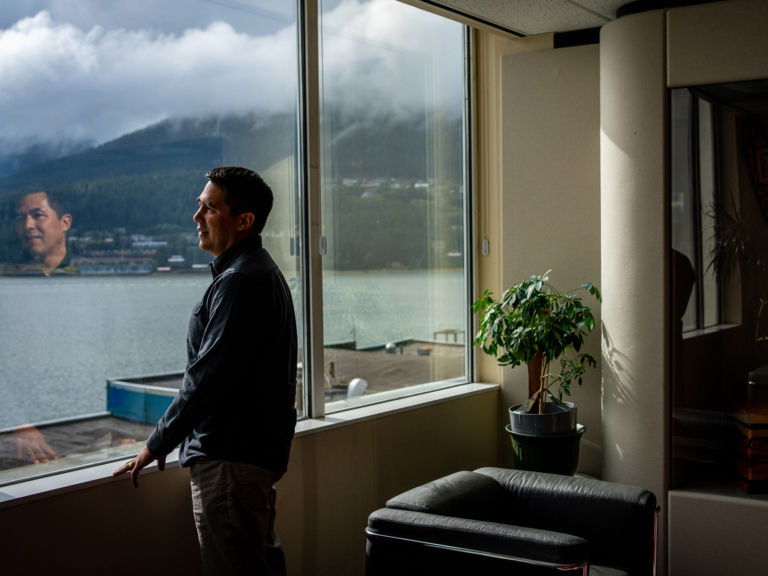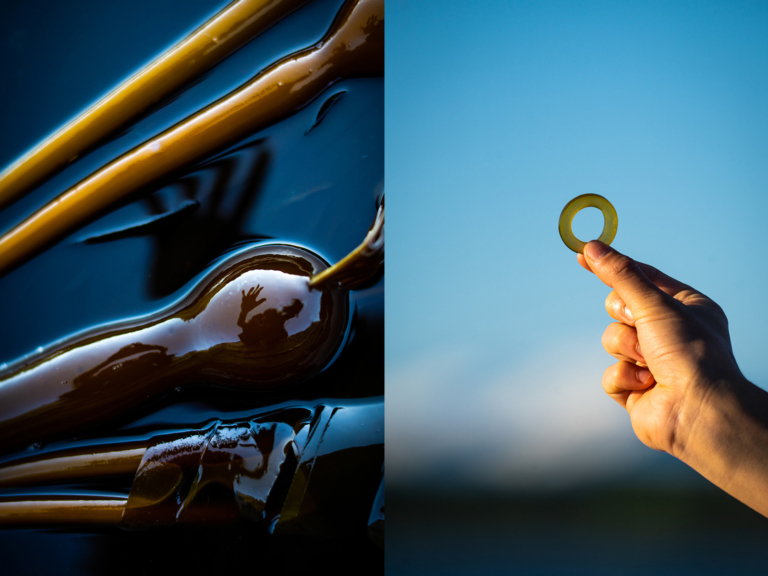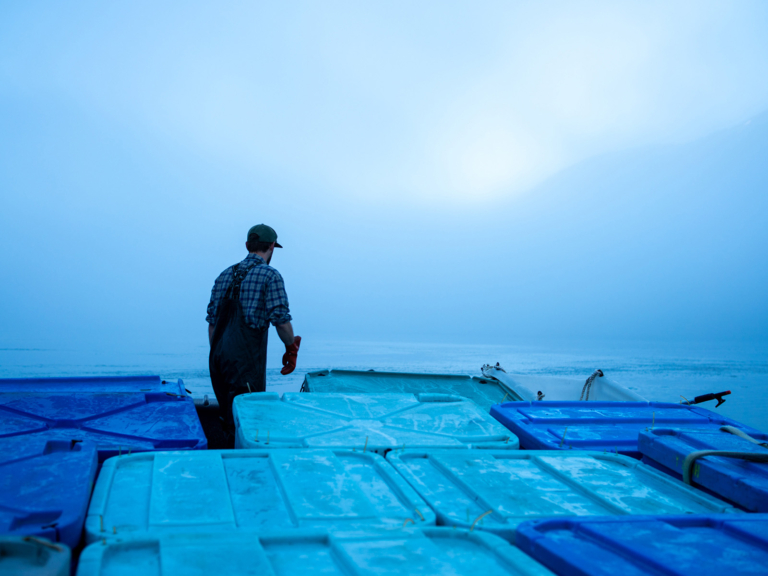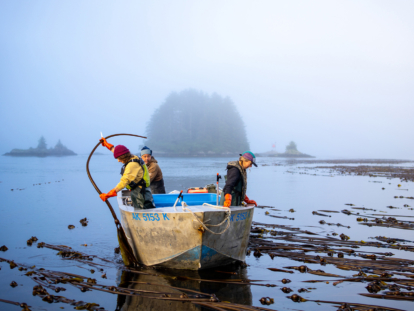Shared Stewardship
All photos by Bethany Sonsini Goodrich
Pacific herring tickle the surface of the water while sheets of rapid movement dart below the boat. Seals zigzag along the horizon spotted with forested islands. It’s 5 a.m. in a remote cove of Southeastern Alaska and the rising sun traps a warm glow below an insulating blanket of marine fog.
The crew on this commercial fishing tender includes Lia Heifetz and Matthew Kern, lifelong Alaskans and the cofounders of Barnacle Foods, a Juneau-based brand of kelp-derived condiments that includes items like pickles and hot sauce. Kaylah Duncan, mid-leap between college and her career, joins the crew as the kelp management intern. Aboard his own seine skiff, Mike Allard arrives through the thick mist from the remote fishing village of Pelican. An avid harvester himself, Allard generously shared the location of these particular kelp beds with Heifetz and Kern. Together, the crew hand-harvests 15 insulated “totes” of Pacific bullwhip kelp during the seven-hour tidal window. Depending on whether they’re fronds or stipes, each tote can hold 400 to 800 pounds of kelp.

Floating buoys rest off of Prince of Wales Island in Southern Alaska. This batch is run by Seagrove Kelp Co., which supplements Barnacle Foods’ wild kelp harvests with farmed varieties. The buoys connect to underwater lines where the kelp is seeded. As this industry grows in Alaska, permitted start-up kelp farms are looking for ways to join the economy and ensure responsible harvesting.

Barnacle Foods’ cofounder Matthew Kern slices the top off a bull kelp stipe. Utilizing the full scope of their harvest, the crew incorporates both the fronds and stipes in their condiments.
Kelp forests are rich undersea canopies that harbor so much life in Southeast Alaska. They’re anchors for sea otters, protective cover for juvenile fish and a hub for herring eggs that feed salmon, whales and sea lions. For nearly 10,000 years, Indigenous peoples have lived in this area, and kelp and seaweed have always been an important component of their diet on this archipelago. Each spring, many Indigenous Tlingit and Haida people harvest herring eggs (called g̲áax’w in Tlingit, k’áaw in Haida) on giant kelp (daaw in Tlingit, k’áay in Haida). Black seaweed (laaḵ’ ásk in Tlingit, sg̲íw in Haida) is lifted off coastal rocks and stored in pillowcases and potato sacs before drying out on sheets and tables. The dried crunchy strands are preserved for snacks, soups and stews. Before colonization, the stipes of bullwhip kelp (sú in Tlingit, hlḵáam in Haida) were used as ropes to set anchors, and the round bladders were storage containers for foods like eulachon fish oil.

Left: Barnacle Foods’ cofounder Lia Heifetz adds more kelp to the haul. To limit any damage to kelp beds, small boats are used in these sensitive areas while a larger, anchored commercial fishing tender waits nearby to collect the kelp.
Right: Day breaks through the marine fog.

Seagrove Kelp Co. rounds up ribbon seaweed for processing in Southeastern Alaska.
As members of the Tlingit community, Allard and Duncan can trace their taste for the coastline’s wild flavors back centuries.
“This is a really unique combination where a private business is working with a Native entity to create a new food culture business,” explains Duncan, whose internship is sponsored through Sealaska, an Alaska Native Corporation and investor in Barnacle Foods. Sealaska is one among more than 200 village and urban corporations established in 1971 through the Alaska Native Claims Settlement Act. The landmark move transferred 44 million acres and nearly a billion dollars to corporations tasked with making profits off those lands for enrolled Alaska Native shareholders.

Anthony Mallott, CEO of the Alaska Native Corportation Sealaska, at his office in Juneau.
Different from a traditional corporation whose identity is often tied to a good or service, Sealaska defines itself by its core Indigenous values and an unyielding responsibility to its 23,000 Tlingit, Haida, and Tsimshian shareholders.
“It’s really important for Alaska Natives and Indigenous people to be tuned in to this innovative and young industry,” says Anthony Mallott, CEO of Sealaska. “It has the potential to benefit us, and we have the potential to make sure that it happens in a way that aligns with our values and what we want to see across our communities.” Sealaska and Mallott—whose Tlingit name is Gunnuk’ and is a member of the Tsaagweidí, Eagle/Killer Whale Clan and also is Koyukon Athabascan, Caribou Clan—were pulled toward kelp for both its economic and socio-ecological promise. By investing in Barnacle, collaborating together and sponsoring interns like Duncan, Sealaska is able to engage directly with the kelp industry as it grows.
That development could be pivotal for the planet. Growing kelp requires little input, no fertilizer and no freshwater. Beyond its nutritional value, kelp is being explored as a biofuel, fertilizer and fiber. There’s also the promising fact that seaweed sequesters carbon and can help deacidify the waters it soaks in.

Left: Wild bull kelp awaits harvesting.
Right: A small quantity of the bull kelp is sliced into the characteristic circles Barnacle Foods uses for their pickles. Beyond bull kelp’s ability to sequester carbon and deacidify waters, the plant is known for its nutritional value as a source of protein, fiber and minerals.
Fortunately, kelp grows quickly, especially in the land of the midnight sun. Of the varieties, Pacific bull kelp—characterized by its long glossy whip-like stipe—is one of the fastest growing organisms on Earth. It can stretch over 2 inches per day until the kelp reaches its relative depth before dying off each year. The forest below our boat may expand nearly an inch before we’re even done harvesting. Compare that, Heifetz says, to harvesting a swath of old-growth trees that takes hundreds of years to mature to their full size.
“We are not removed from the resource or the place that it is coming from and the people we work with aren’t either,” Heifetz says. Rural Alaskans hunt, fish and harvest an average of 295 pounds of wild foods per person each year. “It’s shared stewardship because we all live very close to the land and water. We have a massive responsibility to harvest and encourage kelp farming to develop in a way that helps and does not hurt the ocean resources we all depend on.”

Blue insulated fishing “totes” store the kelp during transport to the processing facility in Juneau.

The crew hand harvests wild bull kelp aboard a small skiff.
Heifetz believes that when business is done well, it can incentivize people to care about the health of a resource like kelp, as well as other growing food industries like those for gooseneck barnacles and swimmer scallops.
Like any emerging industry, the kelp economy is being met with both enthusiasm and trepidation. Thinking back to past experiences, Alaskans fear that without caution and thoughtful policy, kelp could be pursued in ways that concentrate the benefits and wealth among a few, while relegating negative impacts to the rural and Indigenous people knitted closest to these shores. Others worry that outside investors will grab up kelp farming permits around tribal lands that many feel are still healing from a busted timber industry. And some communities are interested in kelp farming but draw the line at wild kelp harvesting.
The need for transparent and early dialogue with tribal councils and communities to ensure that Indigenous and rural entrepreneurs, mariners and researchers are leading the growth is crucial. Kelp farming also needs to be developed in ways that complement Southeast Alaska’s two largest economic drivers—seafood and tourism—without interrupting community hunting, fishing and harvesting rights.
That’s why Barnacle Foods, Sealaska, sovereign Tribal governments, community leaders, entrepreneurs and others are proactively exploring a kelp economy that maximizes environmental contributions, minimizes hazards and provides economic opportunities that are both regenerative and culturally meaningful. Kelp farming is an attractive shoulder-season opportunity for savvy commercial fisherman, many of whom are from Indigenous and rural communities rooted in responsible harvesting traditions. Alaska also holds more shoreline than the rest of the lower 48 combined, with ample room to explore what a more thoughtful, collaborative industry could look like.
“There are not too many examples where economic, community and environmental solutions overlap, and for kelp to even be seen as having the chance to be one of those few means we should focus on getting it right and create those wins for all three areas,” Mallott says. “Maybe by doing so, we can open the pathway to scale up and actively look at what the next ‘win win win’ is.”

Kelp Management Intern Kaylah Duncan has spent two summers alongside Barnacle Foods. As part of her work, she uses drone technology to document kelp bed size and distribution to ensure responsible harvesting.
Balanced on one of the fish totes, Duncan readies the drone she’s using to document today’s wild harvest. The information she collects is part of a mapping initiative Barnacle started in 2021 to better understand wild kelp distribution and abundance in Southeast Alaska. Images show the overall canopy cover of a kelp bed and help the team estimate the number of pounds they can harvest while preserving more than 95 percent of the bed’s biomass. The plan is to collect baseline data and continue annually to ensure responsible harvesting and healthy wild kelp populations.
Right now, Barnacle, which depends on both Alaskan-farmed and wild seaweed, is harvesting wild bull kelp under an experimental fishery permit honored by the State of Alaska. This conservatively run harvest can be closed at any time for any reason under the discretion of the commissioner. Understanding distribution and collecting data is an integral component of transitioning that experimental permit into a permanent one, and Barnacle is working with a long list of partners, including research institutions, to develop a kelp management plan that could initiate a more permanent and regulated commercial harvest.
“How often do you have the opportunity to be part of developing an economy in a way that can truly be positive for communities that are closest to the resource?” explains Heifetz. “With our fisheries, a lot of the management, allocation and planning was done retroactively. With kelp, we are defining that trajectory right now.”
That will require careful exploration on all fronts. Young, old, Indigenous, rural, urban, science-savvy, gritty and innovative—it will take all shapes of Alaskans to build a kelp and seaweed industry that reflects the complex values of this dynamic and abundant region.
They’re working on it. Alaskan hatcheries are growing multiple species of seed for farming. Entrepreneurs are introducing kelp into retail products like soap. Tribal governments are exploring kelp farming as an economic opportunity while understanding how their sovereignty relates to kelp permits sought on waters adjacent to tribal territories. Alaskan Universities are developing programs to inspire a workforce ready for the kelp economy.

Bull kelp reproduces through dark patches of spores called “sori” that fall to the ocean floor upon maturity, leaving holes in the kelp fronds. Sori spores seed the next generation of bull kelp, one of the fastest growing organisms on earth.
For Mallott, kelp is part of a wider investment portfolio that prioritizes ocean and community resilience, a revolutionary idea considering most businesses are driven by the bottom line.
“Sealaska focuses on ocean health because it’s what our communities care about. If they don’t have sockeye and king salmon returning, or access to cockles and crab to keep their freezers full, there won’t be communities,” explains Mallott, who grew up in the Tlingit community of Yakutat (Yaakwdáat), one of the most isolated communities in the US. “Kelp as an agent to assess and offset acidification of the ocean is intriguing and worth pursuing alone. But then kelp also has an economic development component that fits in with rural communities.”
Mallott knows they can’t do it alone, pointing to the village Native corporations, sovereign tribal governments, Indigenous rights and advocacy groups, native housing authorities and other organizations who can work together to share resources and knowledge.
That pursuit of equity and sustainability stretches beyond one industry, one entity or one generation.
Duncan is committed to being part of that collective impact. Pulled home by an ancestral holdfast, she represents an incoming cohort of workforce leaders who aren’t willing to compromise the health of lands and waters, or ignore institutional and societal injustices, in pursuit of profit. For her, healing from colonialism while advancing a more responsible trajectory for Southeast Alaska’s economic future must be done concurrently.

The Fairweather Range at sunset, as seen from Alaska’s Inside Passage while en-route to a kelp harvesting location.
“Whereas my college friends speak about graduation as being able to go anywhere and do anything, for myself, I feel differently,” she says. “Two generations ago, my grandmother didn’t even have the opportunity to speak her Tlingit language in the store she owned selling Alaska Native art to tourists to help send her kids to college. I not only owe it to myself, but I owe it to my ancestors who grinded to get me here, who were unwilling to let go of their culture and knowledge. That’s why I have these opportunities to learn from the mistakes that were made and ensure they don’t happen again.”

